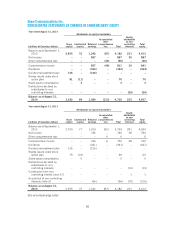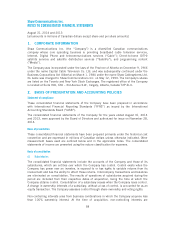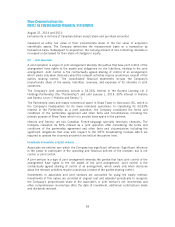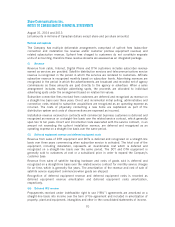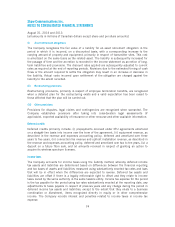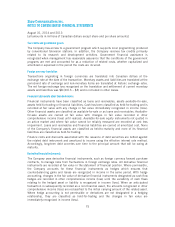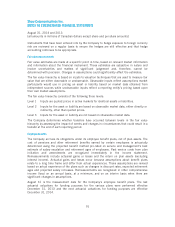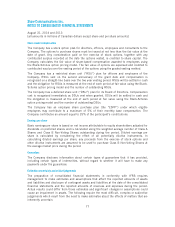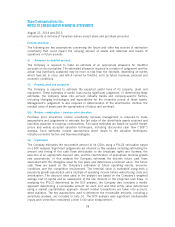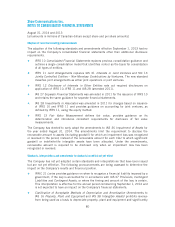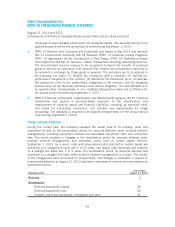Shaw 2014 Annual Report Download - page 76
Download and view the complete annual report
Please find page 76 of the 2014 Shaw annual report below. You can navigate through the pages in the report by either clicking on the pages listed below, or by using the keyword search tool below to find specific information within the annual report.Shaw Communications Inc.
NOTES TO CONSOLIDATED FINANCIAL STATEMENTS
August 31, 2014 and 2013
[all amounts in millions of Canadian dollars except share and per share amounts]
Assets held for sale
Non-current assets and disposal groups are classified as held for sale when specific criteria are
met and are measured at the lower of carrying amount and estimated fair value less costs to
sell. Assets held for sale are not amortized and are reported separately on the statement of
financial position.
Other long-term assets
Other long-term assets primarily include (i) equipment costs, as described in the revenue and
expenses accounting policy, deferred and amortized on a straight-line basis over three to five
years, (ii) credit facility arrangement fees amortized on a straight-line basis over the term of the
facility, (iii) long-term receivables, (iv) network capacity leases, and (v) the non-current portion
of prepaid maintenance and support contracts.
Intangibles
The excess of the cost of acquiring cable, satellite and media businesses over the fair value of
related net identifiable tangible and intangible assets acquired is allocated to goodwill. Net
identifiable intangible assets acquired consist of amounts allocated to broadcast rights and
licenses, trademarks, brands, program rights, customer relationships and software assets.
Broadcast rights and licenses, trademarks and brands represent identifiable assets with
indefinite useful lives. Spectrum licenses were acquired in Industry Canada’s auction of
licenses for advanced wireless services and have an indefinite life.
Program rights represent licensed rights acquired to broadcast television programs on the
Company’s conventional and specialty television channels and program advances are in respect
of payments for programming prior to the window license start date. For licensed rights, the
Company records a liability for program rights and corresponding asset when the license period
has commenced and all of the following conditions have been met: (i) the cost of the program is
known or reasonably determinable, (ii) the program material has been accepted by the Company
in accordance with the license agreement and (iii) the material is available to the Company for
telecast. Program rights are expensed on a systematic basis generally over the estimated
exhibition period as the programs are aired and are included in operating, general and
administrative expenses. Program rights are segregated on the statement of financial position
between current and noncurrent based on expected life at time of acquisition.
Customer relationships represent the value of customer contracts and relationships acquired in
a business combination and are amortized on a straight-line basis over the estimated useful life
of 15 years.
Software that is not an integral part of the related hardware is classified as an intangible asset.
Internally developed software assets are recorded at historical cost and include direct material
and labour costs as well as borrowing costs on qualifying assets. Software assets are amortized
on a straight-line basis over estimated useful lives ranging from three to ten years. The
Company reviews the estimates of lives and useful lives on a regular basis.
72






